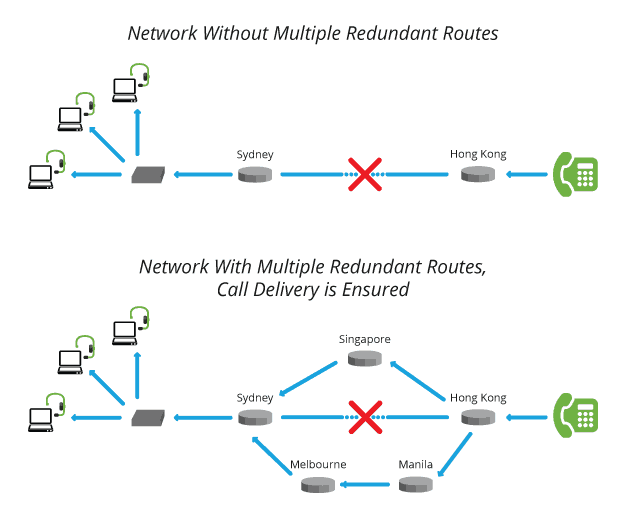Toll Free Number Redundancy to Improve Call Reliability
Toll free number redundancy is a phrase that describes highly reliable, highly available VoIP-based phone service. Businesses that need high reliability and who want protection from network failures rely on service providers that offer fully redundant routing.
Businesses around the world use virtual toll free and local numbers because they provide instant connectivity to markets near and far. These virtual numbers are able to provide this key benefit because they use VoIP (Voice over Internet Protocol), which isn’t limited by the physical hardware and equipment needed for traditional telephony.
If you get a toll free number for your businesses, it is important to ensure that the toll free number provider you choose offers toll free number redundancy and failover for the virtual phone numbers that you will be using. Without this, you could experience downtime because of DNS outages, cable cuts, or data center failures that block some routes on the Internet, or even on the public switched telephone network (PSTN). When your customers cannot reach you on your toll free number or local number, you’ll lose sales, productivity, and even credibility.
What is Fully Redundant Routing?
Fully redundant routing is a network topology that features several reliable, and independent paths between the person who places the call, and the person who receives it. If any link in the network were to fail, other links can be used to deliver the call. This means that service providers have arranged direct carrier interfaces with multiple carriers around the globe.
These same providers have also built redundancy into their own servers, storage systems, and network interfaces. Often the service providers deploy their gear in multiple data centers to prevent any single failure from stopping service. These servers and equipment work together to manage the calls placed over the network so that no single point of failure in the networks can interrupt service.
Redundancy in VoIP networks simply makes it easier for businesses who don’t want to have to worry losing communications with customers for even a short interval because of a network failure or data center failure somewhere in the network.
What is Failover?
Failover occurs when any primary network or system automatically switches to a redundant network or system in the event of failure or any other interruption. This practice ensures higher availability and reliability, especially when it comes to telecommunications.
But in order for toll free number failover, or redundant routing, to work as it is intended, you have to do a little prep work. For example, in the event of a power outage or a network failure, where would you direct calls to your toll free numbers? To another SIP device, the PSTN, or a combination of both?
Ideally, you want to ensure that you had multiple points of failure. In other words, you would choose to direct incoming calls to multiple alternate numbers, devices, or even networks in the event of an emergency. That way, you can be sure that you won’t miss an important call.
Single vs Multiple Redundant Routes
Toll Free number providers understand how important it is for your business to be available 24/7/365. Most toll free providers, including CallForwarding.com, provide multiple provisions to provide both multiple redunant routes and failover, all to ensure toll free number reliability.
The image above shows how a single point of failure, shown as a large red X, can block calls on networks that have only a single route between where the call originates and where the call is supposed to terminate.
The image also shows how networks with multiple redundant routes ensure that each call will be delivered. Fully redundant routing offers several independent, reliable paths to deliver the call. If a network element fails, other links will be used to deliver the call.

